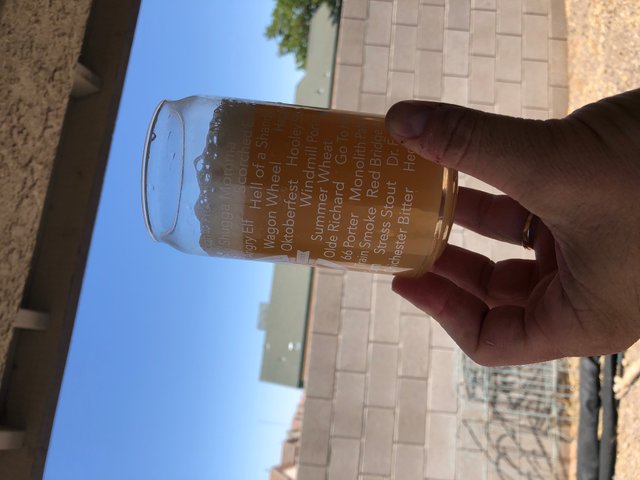Ironically, despite my regular assertion that wheat beers are the best choice for the desert clime in which I live, I realized that I had never made one. I suppose that's not strictly true. Decades ago I did make what I called a dunkelweizen. I clearly remember fermenting this cold, lagering it in an extra refrigerator. I do not remember why I used that method. The beer came out very good, but it was not a traditional method.
I knew hefeweizen was a cloudy wheat beer. I remembered that it usually smelled of banana. But I'd also heard of 'Bavarian wheat beer'. Is that not a hefeweizen? Does calling it "Bavarian" mean something specific? And then there was Weissbier and Hefe Weissbier; the above mentioned dunkelweizen, or dunkles Weissbier. There is Berliner weisse and witbiers. I realized that I’ve drifted away from style exploration, content with assuming I knew the basics and that was enough. I just enjoyed drinking beer, really, in the past several years. So it was time to clarify German wheat beers in my mind.
Therefore, I did a little research into the similarities and dissimilarities of weissbeers, kristall weizen, weizen, hefeweizen, etc. I looked into strictly German wheat beers. So, for example, the witbier I mentioned above is right out since it is from Belgium. The beers written of here are those of Bavaria, the beloved state, for beer lovers, in Germany.
The Wheat Beer Categories
Weizen, or weizenbier, seems to be a comprehensive term that encompasses the wheat beer family. The German word, weizen, does mean 'wheat' so this makes sense that it would apply to beers composed dominantly of wheat malt. Barley is also included as an ingredient but for a beer to be a weizenbier it needs to have at least one-third of its grain bill to be wheat. Usually wheat makes up about fifty to seventy percent of the recipe. Of course, the other key component of weizenbier is the yeast strain. The most well known strain would Weihenstiphan Weizen. If the yeast you use is labelled German or Bavarian wheat that should do it. The yeast contributes heavily to the spicy character of weizenbier.
Weissbier, too, is a comprehensive term for German wheat beers. One article noted that the term weissbier is the most widely used moniker in Bavaria. The word Weiss means 'white' and indicates how much lighter in color the beer is from, say, a brown or a darker bock. A Hefe Weissbier is what you may know more readily as a hefeweizen. Hefe means 'yeast' so a hefeweizen describes a wheat beer with yeast still suspended in the body of the beer. The light colored grains make the beer pale yellow and the suspended yeast makes it turbid or cloudy, also giving it a white-ish or milky appearance.
Therefore, if you go to your local brewery looking for a Bavarian wheat beer, a weizen, a weizenbier, a Weissbier or a hefeweizen know that those are all basically interchangeable terms for a cloudy, pale, refreshing, highly carbonated beer. It will also be spicy, clovey, and possess hints of banana. The phenolic, ester-y character is a style mark of this beer as is the high carbonation. It contributes to its effervescent character which enhances its refreshing nature.
In his book[German Wheat Beer, Eric Warner exposits it this way: "Smell the fruity, spicy aroma of the beer. Roll a small sip onto the tongue and allow it to effervesce. Your mouth should almost explode as the smooth Weissbier fills it. The aftertaste should also be smooth, with only a slight hint of bitterness."

It is a quintessential session beer, which is what so many craft beer drinkers seem to be seeking these days. The beer presents itself unpretentiously. The alcohol is fairly low, ranging from three to five percent abv. There doesn't seem to be a great depth or complexity to it, yet when you stop and evaluate the drink it doesn't lack sensations to explore, whether it's the enticing interplay of banana and clove, or the search for another spice, or the ethereal and tingly carbonation. It's a beer to geek out over and yet it won't overpower you.
But there are more versions than just the hefeweizen.
If you were to brew a hefeweizen and then filter it to remove the turbidity you have a kristall weizen. It should be a limpid specimen, beautiful to look at, but I think it lacks some of the personality of the hefeweizen.
Then there are two styles that intrigue me. First, the weizenbock, a wheat bock. Take a hefeweizen recipe and increase the grain bill so that you've got an original gravity above the 1.065 range. Use some dark Munich malt for a darker hefeweizen, or lighter base malt if you are aiming for a maibock influenced version. Though it is nominally a bock, which indicates a bottom fermenting yeast, use a weissbier ale yeast and ale fermentation temps. All the virtues of the hefeweizen will be engendered along with a firm malt presence. Second, Berliner weisse, a tart wheat beer. Its sharp sourness is derived from Lactobacillus delbrückii pitched with the yeast and it is the sourness that so appeals to me. I can hear our local brewer groaning already. But the spumy acerbity of a Berliner weisse is just grand.
A dunkleweizen, or dunkles weissbier, is a dark version of a hefeweizen. The esters and spice can still be there but conflated and slightly muted by the darker roasted malts, either wheat or barley.
Notes on Brewing German Wheat Beers
Brewing a weissbier at home can be as difficult or as simple as you would like it. As already noted, it is recommended that you use fifty to seventy percent wheat in your grain bill. The remainder should be pale malt of your choice. In German Wheat Beer the author notes that using more than seventy percent wheat may cause lautering difficulty and can cause an amino acid deficiency which can result in poor fermentation and resultant problems.
The mash is where this beer can get complicated, if you so desire. In my recent home brew of a weissbier I did just a simple single infusion mash. I think my mash temperature was a little high at 154 degrees but the beer seemed to be all right. So far. From everything I've read, modern well-modified malts will perform perfectly well in a single infusion mash (and maybe prevent some of the lautering problems referred to in German Wheat Beer). But if you are adventurous there are several protein rests and single and double decoctions that can be performed on this mash. I know there is debate over the value or necessity of decoction, but the procedure is out there if you feel like spending a few hours extra on your brew. It might add some color or extra breadiness which would be valuable in a weizenbock.
The American Homebrewers Association noted that a mash rest at 110 degrees will promote ferulic acid, which converts to 4-vinyl guaiacol. It is that compound that results the phenolic characteristics so important to this beer. Ideally you should also do open fermentation in a shallow vessel, but not all home brewers will be able to swing that. So the mash rest and warmer fermentation temperatures will be the route most of us take to get that clove/vanilla/spicy/et cetera magic. And if you really want to have some fun, look into using some bottom fermenting Speise for carbonation.
A hefeweizen can be completed at home within two to four weeks. Fermentation can be complete in just four or five days if temperatures are maintained. Warm storage (if you bottle) is about a week and then two to three weeks in cold storage. And, of course, tasting during the entire process will let you know when your beer is ready for you.
For a seemingly simple beer there is a great amount of variation and work that can be put into it. Isn’t that the way with all art though? What writer has not put hours and hours into an essay, or spent years writing a novel? What brewer doesn't spend weeks researching and hours brewing and years practicing? The end product is a sleek, polished, fascinating thing to be savored. Only those hours and months of work make it such.
Cheers to German wheat beers.

Congratulations @bottledroger! You received a personal award!
Click here to view your Board
Downvoting a post can decrease pending rewards and make it less visible. Common reasons:
Submit
Congratulations @bottledroger! You received a personal award!
You can view your badges on your Steem Board and compare to others on the Steem Ranking
Vote for @Steemitboard as a witness to get one more award and increased upvotes!
Downvoting a post can decrease pending rewards and make it less visible. Common reasons:
Submit